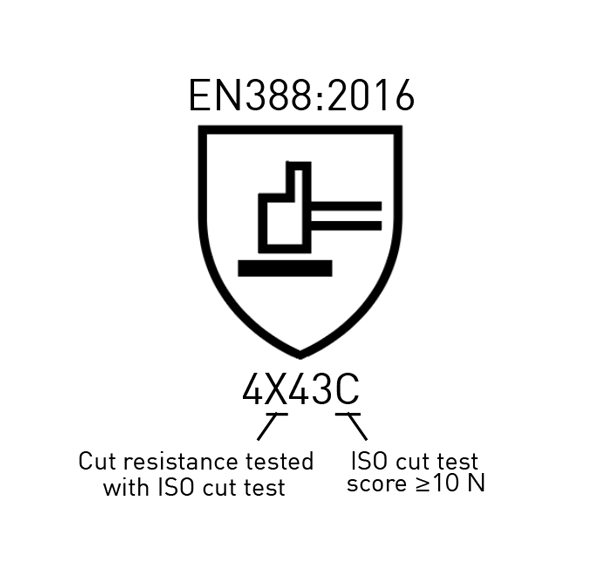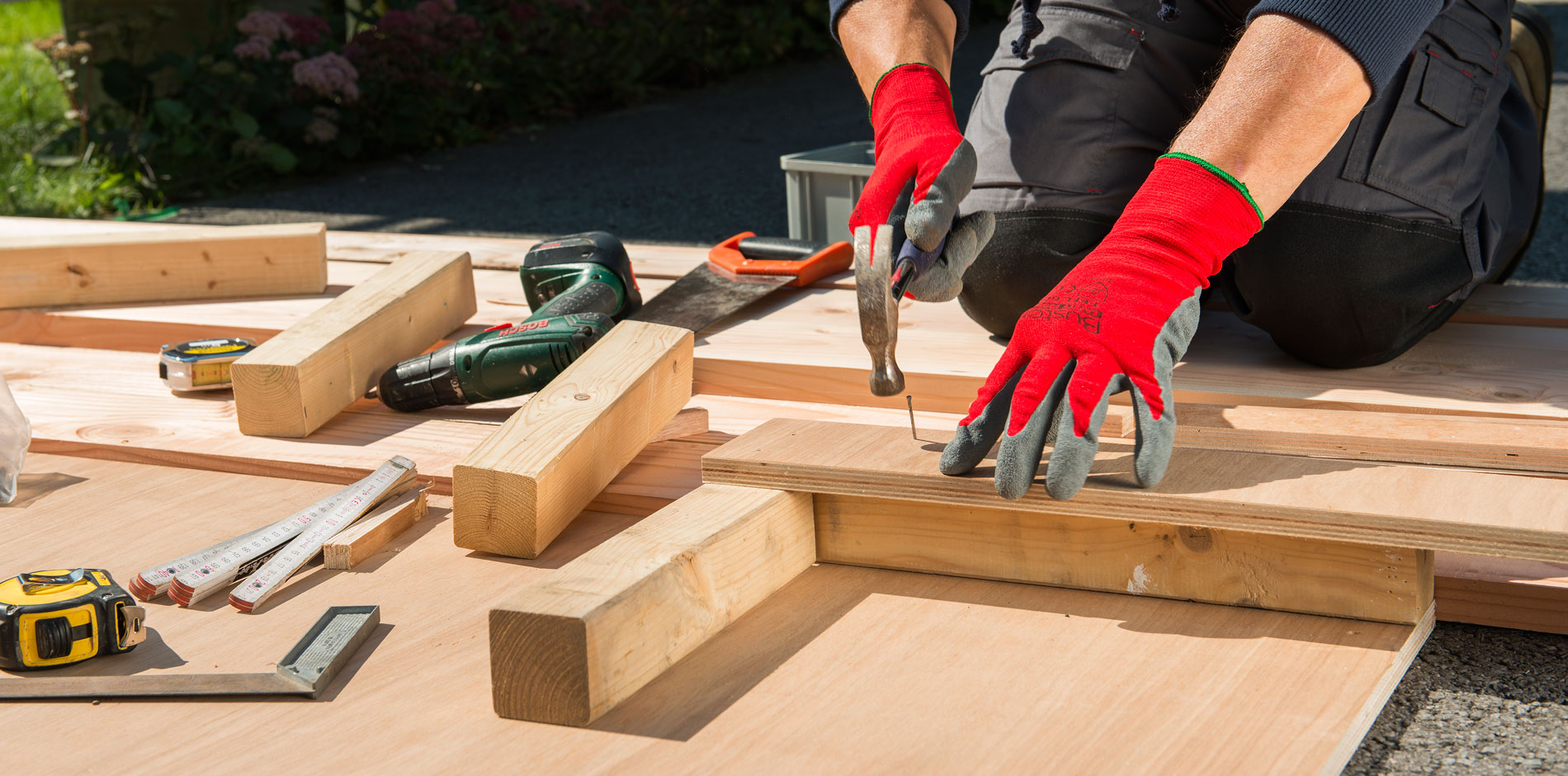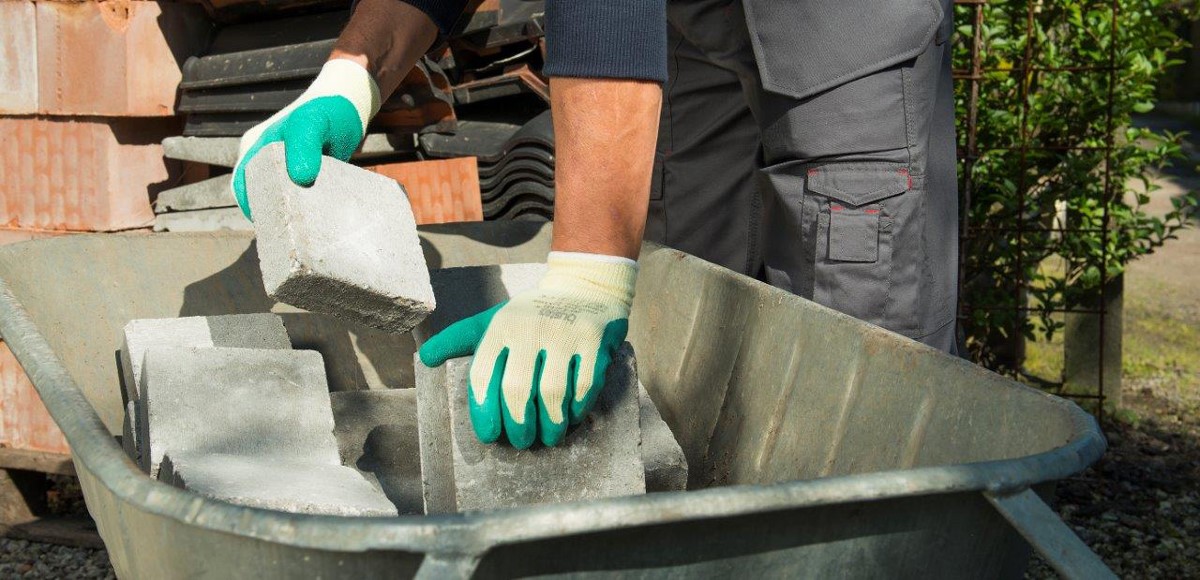Many Busters gardening gloves and work gloves meet the EN 388:2016 standard. But what exactly does this standard mean?
It is not always easy to understand all the different pictograms, standards and quality marks. With the right help, you can find the necessary information on every packaging, so that you can make the right choice at the building supply store. Always follow the instructions in the manual to ensure that the product is used correctly.
Understanding resistances in 1, 2, 3, 4
Gloves that meet the EN 388 standard protect you against mechanical hazards. They have the pictogram of a hammer and a plank. The different types of resistances are:
- Abrasion resistance (A)
- Blade cut resistance (B)
- Tear resistance (C)
- Puncture resistance (D)
- ISO cut resistance (E)
- Impact protection (F)
Understanding the pictogram
The example pictogram below uses letters. On the packaging, though, these letters are replaced by the test scores, expressed in numbers and other letters. The numbers specify how well the gloves score with regard to the types of resistances listed above. Of course, not every score has to be high. If, for example, you want to remove a thorn bush from your garden, the puncture resistance of the gloves is very important, but the tear resistance is less important.

How are the gloves tested against the EN 388 standard?
 The score tells you how often the work gloves can be sanded, pricked or cut before they fail. The higher the number, the better the protection against this hazard.
The score tells you how often the work gloves can be sanded, pricked or cut before they fail. The higher the number, the better the protection against this hazard.
For example, the Anti Cut cut-resistant gloves from Busters meet the EN 388 standard with a score of 4X43C. These gloves have a high puncture resistance and a high ISO cut resistance, which means they are ideal for wearing when working with sharp tools. The X score may be a bit confusing, but is easily explained: if the gloves have undergone an ISO cut resistance test, the standard cut resistance is not also tested.
Abrasion resistance
Abrasion resistance is expressed in a score from 1 to 4. The score is determined by the number of cycles needed for the palm to be worn through. Or in other words, the number of times that the palm can be sanded before it loses its protection.
It is recommended to use safety gloves with a high abrasion resistance for tasks involving rough materials.
- A score of 1 means the gloves are able to withstand a minimum of 100 cycles
- A score of 2 means the gloves are able to withstand a minimum of 500 cycles
- A score of 3 means the gloves are able to withstand a minimum of 2,000 cycles
- A score of 4 means the gloves are able to withstand a minimum of 8,000 cycles
Cut resistance
Cut resistance is expressed in a score from 1 to 5. The score is determined by the number of cycles required to cut through the material of the gloves. The score, or index, is a combination of tests undergone by the gloves and a reference material.
- A score of 1 means a protection index of 1.2
- A score of 2 means a protection index of 2.5
- A score of 3 means a protection index of 5
- A score of 4 means a protection index of 10
- A score of 5 means a protection index of 20
“X” means that the gloves have undergone the ISO cut resistance test. This test replaces the standard cut resistance test.
Tear resistance
Tear resistance is expressed in a score from 1 to 4. The resistance is expressed by the force in newtons that is required to tear the palm of the gloves.
- A score of 1 means the gloves are able to withstand a minimum force of 10 N
- A score of 2 means the gloves are able to withstand a minimum force of 25 N
- A score of 3 means the gloves are able to withstand a minimum force of 50 N
- A score of 4 means the gloves are able to withstand a minimum force of 75 N
Puncture resistance
Puncture, or penetration, resistance is expressed in a score from 1 to 4. The score is expressed by the force in newtons that is required to puncture the palm of the gloves. Or in other words, how hard a sharp object can be pressed into the palm of the gloves before the glove is punctured. If you work in the garden or work with sharp tools, be sure to choose work or gardening gloves with a high puncture resistance.
- A score of 1 means the gloves are able to withstand a minimum force of 20 N
- A score of 2 means the gloves are able to withstand a minimum force of 60 N
- A score of 3 means the gloves are able to withstand a minimum force of 100 N
- A score of 4 means the gloves are able to withstand a minimum force of 150 N
ISO cut resistance
Gloves that claim to offer a high cut resistance must have passed the ISO cut resistance test. This test replaces the standard cut resistance test. The score (a letter between A and F) is determined by how blunt the knife gets during the test.
This test is a recent addition. Gloves for which the previous certification is still valid have the old pictogram, which displays the first four types of resistances.
Impact protection
The final score below the EN 388 pictogram is the letter P (or nothing if the gloves have not undergone this test). This is an impact test for gloves that protect against impact by having, for example, rubber pads on the top of the gloves. The gloves pass the test if there are no tears or cracks in the gloves after an impact of 2.5 kg. The maximum permitted transferred energy is 7 kN. Only certain work gloves undergo this test. No score is specified if the gloves have not undergone the test of if they did not pass the test.
This test is also a recent addition. The current certificates are still valid and, for that reason, not all our safety gloves give this resistance.
Aside from the EN 388 standards there are also extra standards for specific hazards. For example, a standard to specify how well the work gloves protect against heat or to what extent gardening gloves are waterproof. Use the pictograms of all the standards to select the correct protection for each task.
Summary
Always protect yourself as well as possible. Choose the appropriate personal protective equipment for a specific task. This way, you will not only work safely, but also better and more comfortably.
- Choose the right scores for a specific task
- Take the possible risks into account and use maximum protection
- Look for specific standards, such as EN 374 (protection against liquids).
- Always work comfortably and safely
- Tip: Do not forget to wear a dust mask, safety glasses and other personal protective equipment
- Tip: Find the product you need in your nearest building supply store or garden centre


